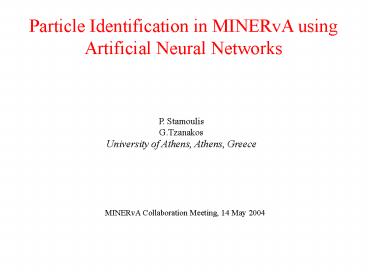Particle Identification in MINERvA using Artificial Neural Networks - PowerPoint PPT Presentation
1 / 9
Title:
Particle Identification in MINERvA using Artificial Neural Networks
Description:
Define characteristic, separating variables for each. class Form ... We have widely used ANNs for interaction classification: -Niki Saoulidou in DONUT ... – PowerPoint PPT presentation
Number of Views:40
Avg rating:3.0/5.0
Title: Particle Identification in MINERvA using Artificial Neural Networks
1
Particle Identification in MINERvA using
Artificial Neural Networks
P. Stamoulis G.Tzanakos University of Athens,
Athens, Greece
MINERvA Collaboration Meeting, 14 May 2004
2
Stating the obvious
- Cross-section measurements in Minerva
- Interaction classification
- Particle Identification
- In principle, it should work with simple cuts in
some very clearly - discriminating variables (e.g. length,dE/dx for
p/?) - But there are some special discrimination tasks
- Low energy particles, penetrating ?/?, ?/?-
- There, a multivariate approach like ANNs can do
better
3
ANN basics
- Define characteristic,
- separating variables for each
- class Form patterns (MC
- events).
- Train the ANN with these
- patterns.
- Use trained ANN to separate
- real events.
- The result is the Bayes a
- posteriori probability that the
- event/particle belongs to the class
step functions
Many available packages (simple or not,
supported or not) MLPfit, SNNS, ROOT embedded
TNeurons
We have widely used ANNs for interaction
classification -Niki Saoulidou in DONUT -Niki
and Athens U. group in MINOS Far Detector -PID in
MINOS CalDet
4
Performance example The CalDet e/(h,?)
separation at 0.6 GeV/c
The Input
Sample of (25 in total) separating variables
usedTotally overlapping, but with distinct shapes
The Result
5
Examples of p/?/? separation Stating the problem
Simple MC event display (á la Howard, using
ROOT) 2 resonance scattering examples shown (from
Steves ntuples)
Seeing many of these, we decide on possible
separating variables
6
Discriminating variables
CAUTIONResults before digitization and any
tracking/clustering!!
7
The hard part Separating pis of different charge
Important to separate different resonance
production interactions
- dE/dx, total track length, opening angle,
obviously wont - work
- Chose to look at stopping patterns of produced
particles - showers - electrons
- b. Shower energy Electron energy
- c. Shower/Electron opening angle (?)
- d. Track length before interaction or decay
(Inconclusive before tracking proceeds)
Modified MC Hugh
?-
?
1 GeV/c
8
Different stopping behaviour of pi- and pi
0.1 GeV/c
0.4 GeV/c
0.8 GeV/c
1.0 GeV/c
Electron and shower multiplicity
?
?-
Electron and shower total energy
9
What needs to be done -Actually create an ANN,
train on MC and see discrimination
quality. -TRACKING !! Working with the whole MC
truth info does not tell the whole truth of the
the power and limitations of the technique. -MC
tuning (?) It is possible that this effect will
go away or become less significant when using a
different hadronic interaction MC. -Expansion Deci
de whether to use the technique on PID or
interaction separation.































